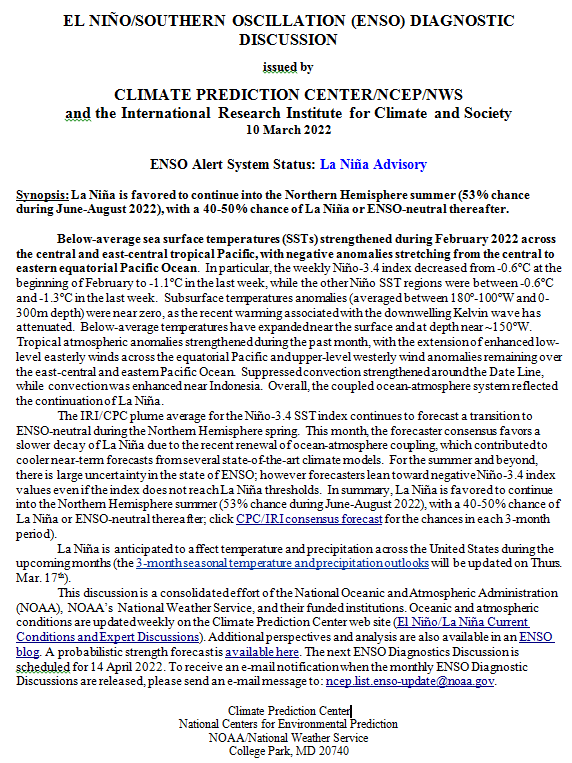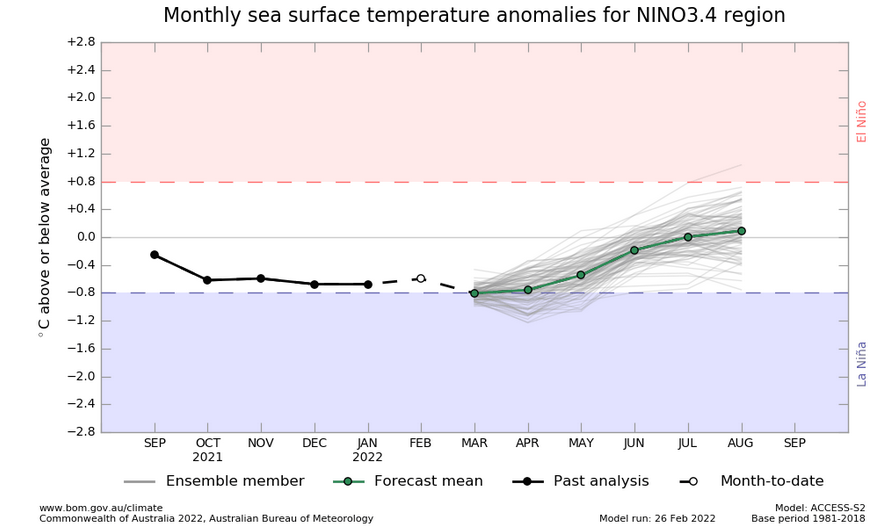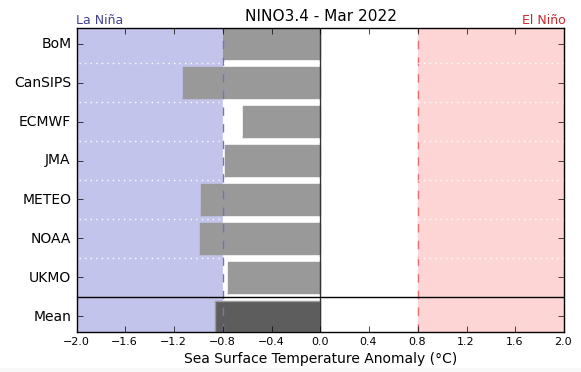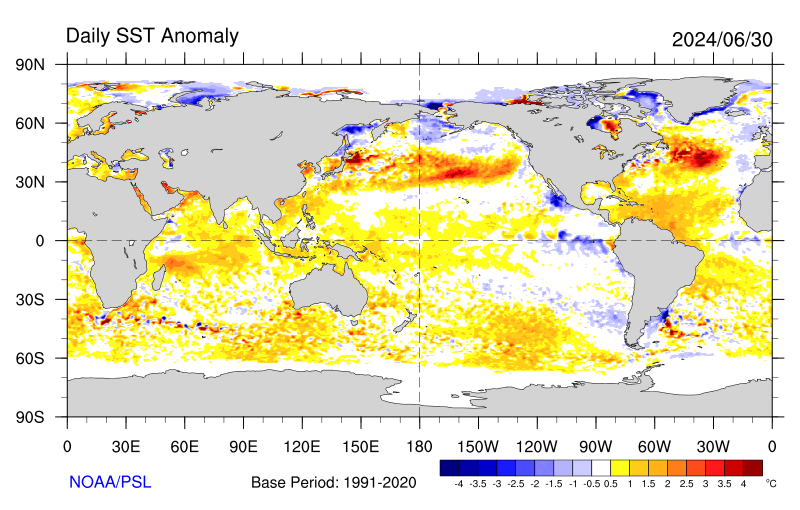On the second Thursday of every month, NOAA issues its analysis of the status of ENSO. This includes determining the Alert System Status. Although the current status remains the same i.e. La Nina Advisory, the forecast has been adjusted somewhat from last month. The forecast calls for the La Nina to continue to fade perhaps but right now it is stronger. The timing is shown in the NOAA discussion and the IRI probability analysis. Of importance, the chances of a Triple Dip La Nina are not ruled out. That could be a real disaster for the Southwest and the West Coast.
The impact of the NOAA forecast for the transition from La Nina to ENSO Neutral will show up next Thursday when NOAA issues its Seasonal Outlook. The NOAA ENSO Status Update provides an advance indication of how the forecast might change. There is a lag between the ENSO state and the impact on U.S. weather. Thus the exact date when a fading La Nina meets the criteria for ENSO Neutral may not be very important in terms of the actual impact on Spring and Summer weather including the North American Monsoon (NAM). But the possibility of a Triple Dip should be of considerable concern. We will learn what NOAA thinks next Thursday.

CLIMATE PREDICTION CENTER ENSO DISCUSSION
The key message is that we remain in La Nina. But it has weakened but it is not exactly clear when it will end. It is not likely to end during March through May – It has a fair chance to transition to ENSO Neutral during the three-month period May through July. More on that later.
IRI CPC ENSO STATE Probability Distribution (IRI stands for the International Research Institute for Climate and Society
Here are the new forecast probabilities. This information is released twice a month and the first release is based on a survey of Meteorologists. The probabilities are for three-month periods e.g. JFM stands for January/February/March.

Early February ENSO Probabilities
Sometimes it is useful to compare this to the forecast from the prior month. I do not have that handy but I do have the forecast from the second half of February. That forecast is based on the computer model results from around the world. Thus there is a certain amount of comparing apples to oranges – But I think it is still very useful to compare the two forecasts.

This is a big change. Sometimes it is useful to look at the data from the prior month and here it is.
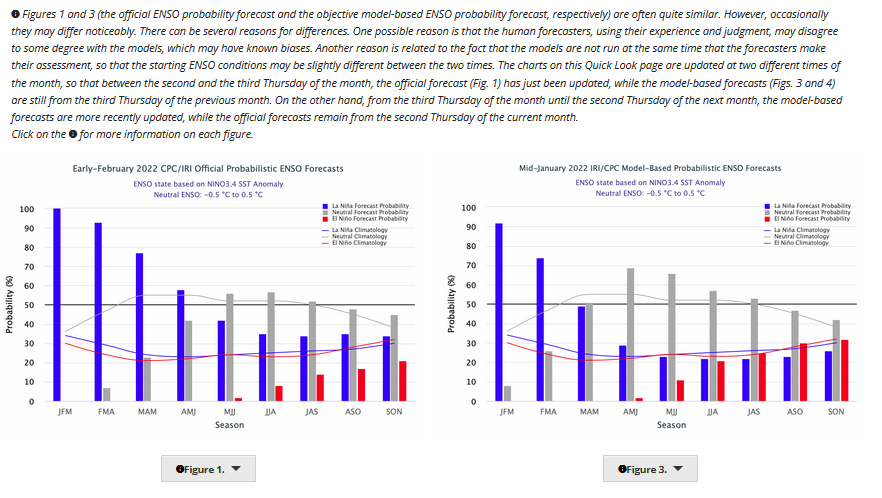
You can see the same pattern where the first forecast which is based on a survey of meteorologists is less optimistic about the end of the La Nina than the computer models which show up in the mid month forecast. But if you compare the first forecast last month to the first forecast this month you see that last month it seemed that the La Nina was more likely than not to be over in MJJ and this month even in JJA it is equal odds. So that is a very big change.
What Does the NOAA Proprietary ENSO Model Forecast?
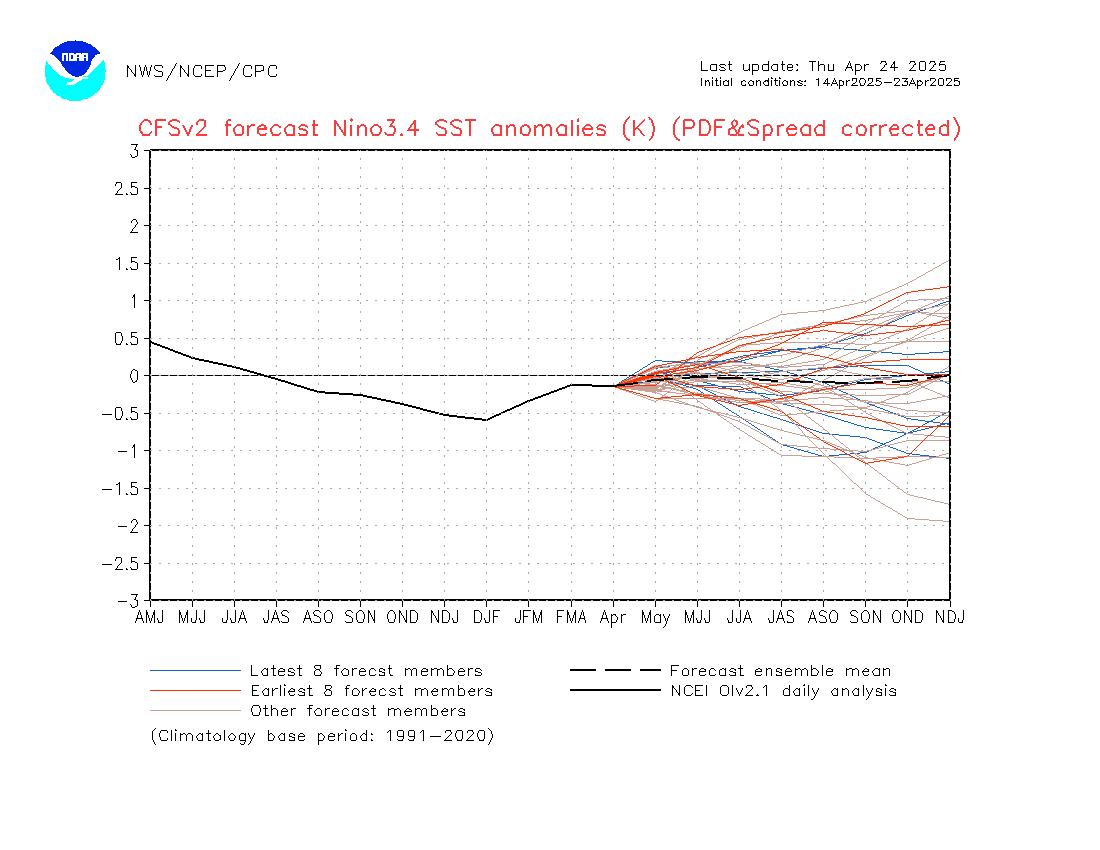
The above should auto-update. If it does not update you can click here https://www.cpc.ncep.noaa.gov/products/people/wwang/cfsv2fcst/images3/nino34SeaadjPDFSPRDC.gif This model shows La Nina continuing indefinitely even getting a little stronger and IRI does not agree with what this model says. Usually what is called the Spring Prediction Barrier applies more to when an El Nino will begin than when a La Nina will end. But perhaps that is a factor right now.
I like to compare forecasts from other meteorological agencies and I do not yet have the forecast from JAMSTEC but I do have the ENSO forecast from the Australian Bureau of Meteorology (BOM).
The BOM has a different threshold for what constitutes a La Nina so they are showing it ceasing to be a La Nina in April. But even if you use the NOAA criteria the BOM forecast would end the La Nina by May. The BOM criteria probably reflect what values of the Nino 3.4 Index cause La Nina conditions in Australia.
BOM also shows the results of other models and they all show that we are currently in La Nina.
Sea Surface Temperature Anomalies
Where is ENSO Measured?
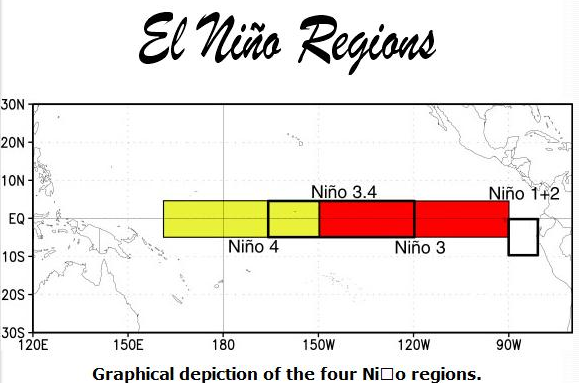
The above shows areas along the Equator and extending in some cases five degrees north and south but for the Nino 1 + 2 area it extends from the Equator ten degrees south. In the U.S., meteorologists have found that conditions in the eastern part of Nino 4 and all of Nino 3 are the best guide to the phases of ENSO and that area is called Nino 3.4 and that is where the focus is for the U.S.. China pays more attention to Nino 3.0. It might be that Global Warming is changing where we should look. But that is beyond the scope of this article. But it should be kept in mind.
Here is the latest.
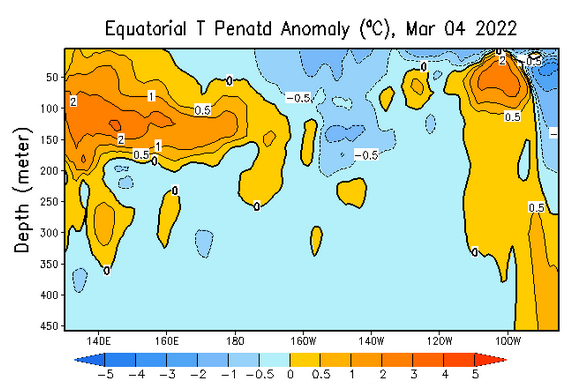
Here we are just looking at the Equator but from the surface down to 450 meters. And we are looking at the temperature anomalies. The Nino 3.4 Index is measured at the surface but the subsurface may become the future surface. There is anomalously cool water almost everywhere on the surface but there is a a large warm anomaly that might disrupt that but it is east of the 120 degrees where the the Nino 3.4 index is measured. Off to the west, the warm Indo-Pacific Warm Pool has receded and is not very intense with maximum anomalies of 2 degrees Celsius. And we must remember that these anomalies are calculated based on the seasonal norms for water at that depth. So two degrees warmer than usual does not mean it is warmer than the water at the surface. So it will not automatically rise.
I realize that is complicated. But it is important to understand. The analysis updates every five days but the graphics in this article are frozen. However, an updated version of this graphic can be found at https://www.cpc.ncep.noaa.gov/products/analysis_monitoring/ocean/weeklyenso_clim_81-10/wkteq_xz.gif. It comes with an upper graphic like the image shown above which is the temperature anomalies. It also has a lower graphic which is the actual water temperatures. Both are useful.
And this is what it looked like last month. There was a lot more warm water encroaching. What has changed?
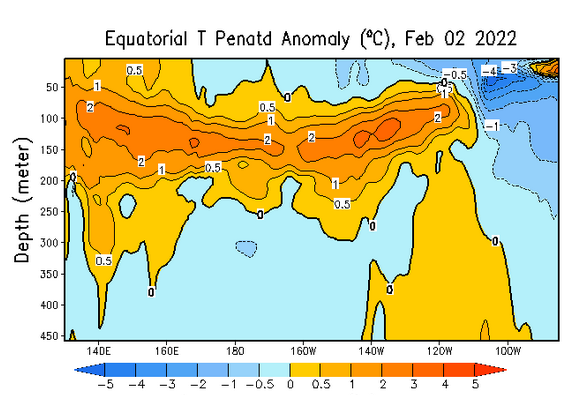
And the prior month. There was less but still more that this month.
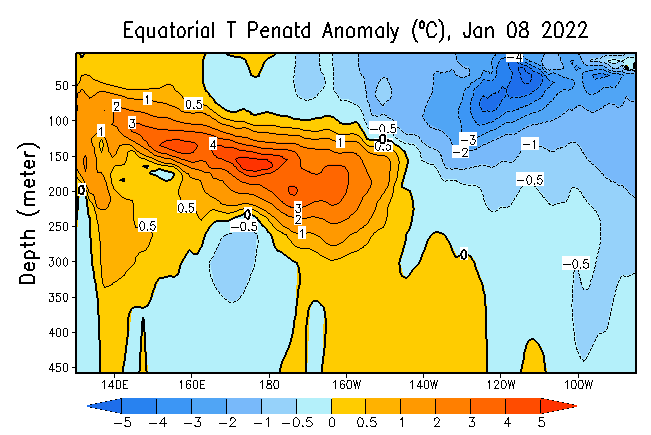
So in early January and early February there had been a lot of progress in moving warmer water under the cool water and replacing it which explains the reduction of the intensity of the La Nina. This suggested then that the IRI probabilities might be incorrect and the La Nina may be gone sooner rather than later. Now it looks like later rather than sooner.
Additional Information
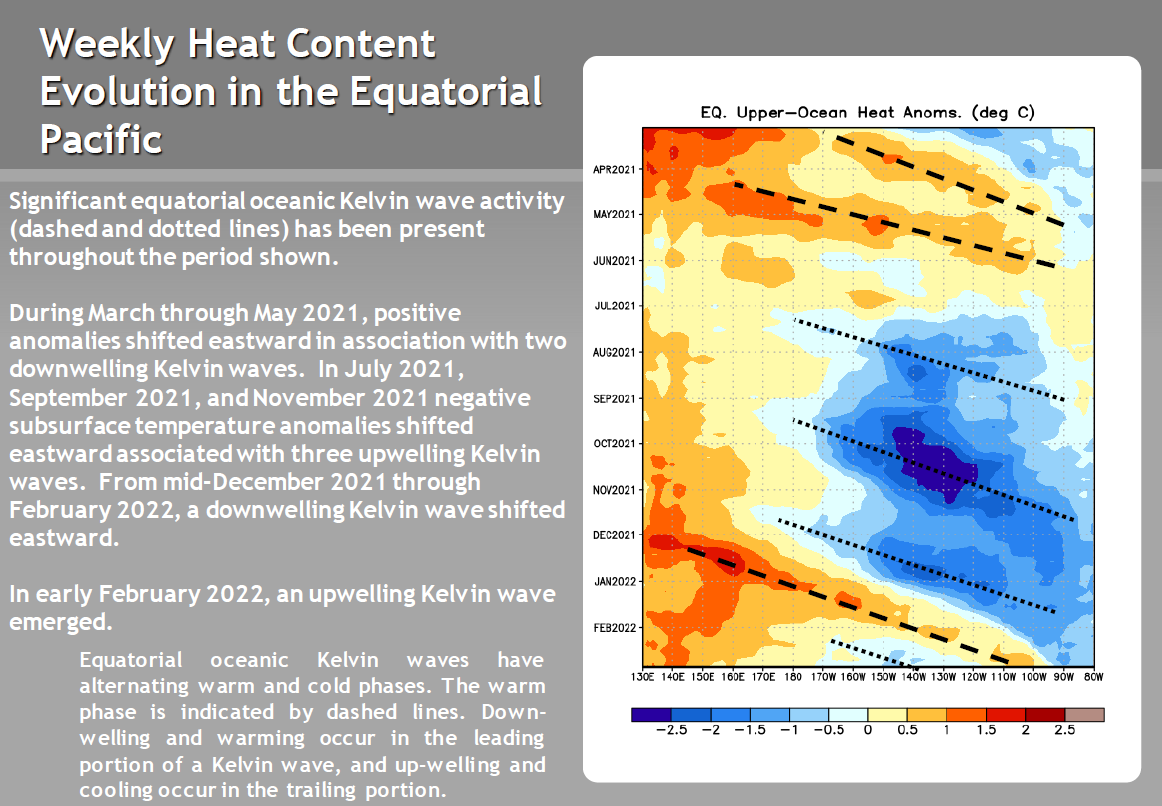
Impact of Kelvin Wave
Last month we say the downwellling action of this Kelvin Wave. Now we see the hint of the upwelling portion shown by the dotted rather than the dashed lines. The downwelling phase was moving warm water east. The upwellling phase is allowing cooler water from below to surface. Remember that weather is related to the surface of the ocean not what takes place below the surface.
What is a Kelvin Wave?
I am not going to provide a full explanation in this article as it would be a distraction. Let’s just say that a La Nina skims off warm water at the surface and moves that warmer water to the west which adds it to the Indo-Pacific Warm Pool. The IPWP slowly expands to the east and certain events trigger some of that water to move farther east. That warmer water nudges a La Nina towards ENSO Neutral or nudges ENSO Neutral towards El Nino. The warm water is close to the surface and the leading edge of this is called the downwelling phase. That is then followed by an upwelling phase sometimes called the trailing edge. NOAA makes it easy for us by adding dashed lines and dotted lines to the graphic. The explanation is also to the left of the graphic that shows the history of these waves.
I do not know if this is the best explanation as it is very technical but I am providing it for those interested. One can always do a search on any term that is in my articles to obtain more information. Here is a good highly technical reference https://www.sciencedirect.com/topics/earth-and-planetary-sciences/kelvin-wave. Remember this is an Equatorial Oceanic Kelvin Wave. There are other kinds of Kelvin Waves.
Has this Equatorial Oceanic Kelvin Wave eliminated the La Nina?
The answer is no but that it had contributed to the weakening of the current La Nina. But the La Nina looks moderately strong now. I think the image will update daily. If not you can obtain updates by clicking on https://psl.noaa.gov/map/images/sst/sst.daily.anom.gif
Another way of looking at it is the impact on the atmosphere. Here we show the near-surface winds.
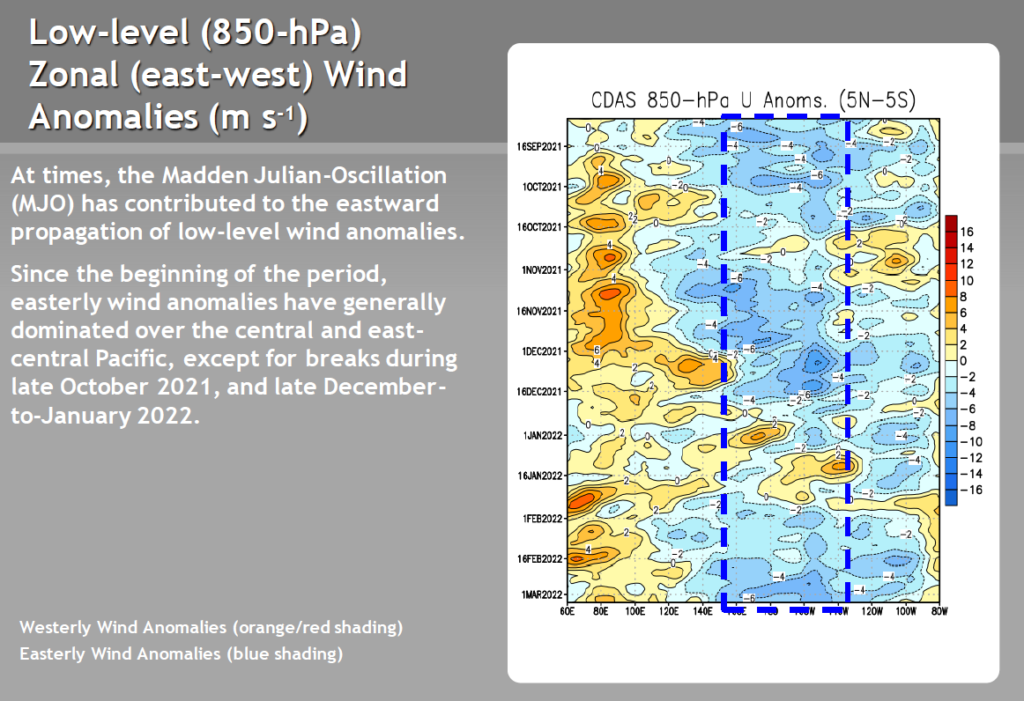
This type of diagram is called a Hovmöller diagram. It is sort of like a tape that records the information and adds the current information so that the bottom of the diagram is the most recent information and the earlier information is shown above it. So you can see the warm event back in December and how it moved to the east. There is really no sign of it now in the atmosphere. I assume that it was an MJO event. This type of diagram allows one to see what occurred over a period of time.
CDAS is is not as clear as it could be when describing wind anomalies. They could use a little remedial English. My best guess is that a westerly wind anomaly is stronger than normal and an easterly wind anomaly is also stronger than normal. They could be more clear about that but the color coding is clear for the westerly wind anomalies but the blues for the easterlies are not as clear and for me the minus sign is confusing. It theory you can deduce what they mean to say from looking at the transitions from westerly anomalies to easterly anomalies. You see paler shades of orange/red transitioning to paler shades of blue meaning the westerly anomalies are becoming weaker and weaker so that means the winds are becoming more easterly (I think). [it is cruel to make someone of my age have to think this hard]. So I conclude that we now have strong easterlies along the Equator and this should help allow warm water to surface if it was there but it is not there.
So I think that may be what is confusing the meteorologists.
My conclusion is we do not know yet when this La Nina will be over if ever. I take that back, La Nina can not persist forever but there could be a Triple Dip which would cause a lot of problems.
What are the Typical Spring Impacts of La Nina

For winter we focus a lot on the Jet Stream. Now we look at the process a bit differently and here is shows the statistical impact of El Nino and La Nina on temperature and hail storms. It is pretty dramatic. It still comes down to the Jet Stream and the location of where air masses clash. But the impacts would seem to be greater with La Nina.
ENSO is not the only factor that impacts our weather and no two El Ninos or La Ninas are identical. But it is a major factor so we pay a lot of attention to it.
